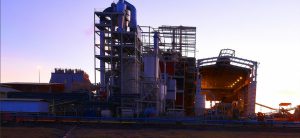SA Mining
A Sector In Crisis?
Platinum miners are describing their sector as one in “crisis”. In an effort to understand the fundamentals (demand and supply) driving platinum group metals (PGMs), SA Mining recently caught up with Afriforesight’s chief chrome and PGM markets analyst Ayanda Makupula to unpack the trends influencing the sector.
How would you describe the current state of the PGM market?
We can’t determine what the state of the PGM market is without describing the underlying trends in the global automotive market where autocatalyst demand accounts for 40% of platinum and over 80% of palladium and rhodium. There are currently two major trends in the auto market: a move away from internal combustion engines (ICEs – cars that run on petrol/diesel) to electric cars; and within the ICE market, there is a shift away from diesel towards petrol.
Due to this shift in demand, the PGM industry is currently undergoing a major shift in supply as pricing follows the shifting trend in the European and global auto market.
Supply: South Africa accounts for the largest share of platinum (70%) and rhodium (80%), and is the second largest after Russia in palladium (40%). Production from South Africa is expected to slowly decline as producers shut shafts in the eastern and western limbs of the Bushveld Complex, but cushioned by low-cost mines popping up in the palladium-rich northern limb. The low platinum price, exacerbated by a strong rand, is squeezing producer margins but some support from higher palladium and rhodium prices will continue to cushion this tightness. Russian and North American producers are currently the most profitable as higher palladium prices mean higher revenues due to its larger share in their basket.
How have PGMs performed in the past six months? What were the driving factors?
As indicated, the PGM industry is mainly driven by the automotive market where the different PGMs are used to clean up car exhaust fumes prior to release to the atmosphere. Platinum is mainly used in diesel cars (it can perform as well in petrol cars), palladium is used in petrol cars and rhodium is used in both diesel and petrol cars. The following trends were expected:
Platinum performed the worst in 2017, but regained some value (+1.4%) in the past six months, as the ongoing anti-diesel sentiment in Europe caused by Volkswagen’s 2015 “Dieselgate” continues to dampen demand. Diesel car sales in major European Union countries such as Germany and the UK declined 21% and 33% in the first quarter respectively. Price increase was due to fears of low supply from South Africa as the stronger rand and low prices forced some producers to shut down shafts, for example Amplats (2017) and Implats (2018). Prices are expected to increase significantly from the second half of 2018 as jewellery and safe haven demand picks up, further supported by fuel cell-led investment demand.
Palladium fared better but has since retreated (-3%) as the high prices encourage a greater sell-off in exchange-traded funds (-25.1%). The price boom for palladium was at the expense of platinum as the market-shift away from diesel to petrol meant higher demand for palladium – these high prices were last seen in early 2001 when Russian supplies were disrupted by political uncertainty while demand from the auto sector was on the rise.
Rhodium is the best performer (+35.1%) as it, like palladium, gained from the anti-diesel sentiment. Rhodium is used in both diesel and petrol cars to reduce NOx to less harmful nitrogen and oxygen. The main reason for the price jump was that old cars needed to be retrofitted with new hardware while a rise in petrol car sales also gave support, as was the case with fears of low supply from South Africa, lifting prices further.
What are the challenges this sector currently faces? Are there opportunities to mitigate these challenges?
The South African PGM market is currently under immense pressure as low margins due to low platinum prices and the strong rand are forcing producers to idle high-cost shafts. Low profitability can be mitigated by closure or curtailments of output.
However, the South African government could help the industry in fast-tracking the development of the fuel cell industry, which could potentially absorb a chunk of the demand lost from autocatalysts. Some PGM miners, for example Amplats and Implats, have started introducing such opportunities at their operations. Implats has already introduced hydrogen-powered forklifts and stationary fuel cell power generators at its Springs refinery while plans to debut underground fuel cell dozers have been tabled by both Amplats and Implats.
Essentially it all needs to start at home: South Africa has a lot more opportunities available to drive the fuel cell industry forward such as encouraging the use of fuel cell power to help set up mobile clinics in remote areas, and electrifying rural South Africa in general.
How has recycled platinum affected new demand?
Recycled platinum increased by about 3% over 2017 and contributed about 24% to global supply, which significantly reduced South Africa’s share to 55% of global supply compared to 72% of mined supply.
Recycling is set to increase further in the next few years as more diesel vehicles’ autocatalysts (about 60% of recycling) become available due to the ongoing anti-diesel sentiment. The availability of cars for scrapping is not the only driver for recycling; the price of steel scrap is the main driver as recyclers chase profits in this tight-margin industry.
Is legislation related to the automotive sector affecting PGM demand?
The impact of legislation in the automotive sector is both positive and negative for PGM demand, as there is a general shift away from polluting vehicles towards cleaner cars.
Positive: New laws on car exhaust emissions require automakers to reduce harmful emissions of carbon, hydrocarbons, nitrogen and particulates. In order to achieve this reduction, PGM catalysts are required and for optimum results one has to load more catalyst. Palladium is therefore expected to gain from a shift to more hybrids as these require much higher catalyst loadings due to engines’ relatively lower operating temperatures. Platinum will gain from use in fuel cell vehicles. A threat exists as US President Donald Trump is set to roll back vehicle emissions standards set out by his predecessor Barack Obama. However the state of California indicated that it would fight this move.
Negative: The move away from ICEs will affect PGM demand negatively as most electric cars use non-PGM-containing batteries, such as lithium-ion batteries.
What is the outlook (demand/supply) for PGMs in 2018?
The outlook for demand/supply for the three PGMs differs, although it’s driven by the same factor. Platinum has a slightly negative outlook in 2018 as the diesel taint continues to weigh negatively on demand. But this decline is expected to be cushioned by a rise in the jewellery market, safe haven buying with more geopolitical tensions and some replacement of palladium in petrol cars. Supply is expected to decline in 2018 as South African miners curb output due to tight margins as done by Amplats and Implats.
Palladium has a positive outlook, although this optimism may lead to its demise. Petrol car sales growth (at the expense of diesel) coupled with more stringent laws on emissions will benefit palladium, but the sharp rise in prices due to demand rising faster than supply should weigh on demand. Supply is expected to increase as North America and Russia ramp up, further supported by higher output from South Africa’s northern limb of the Bushveld Complex (all these regions have more palladium than platinum in their ore bodies).
Rhodium is expected to increase the most as it gains from both new car sales (petrol and diesel) and retrofits of older polluting diesel cars in the EU in order to combat pollution while avoiding driving bans. Supply should fall on closure of South African shafts (80% of global supply).







 Sign-up and receive the Business Media MAGS newsletter OR SA Mining newsletter straight to your inbox.
Sign-up and receive the Business Media MAGS newsletter OR SA Mining newsletter straight to your inbox.